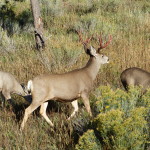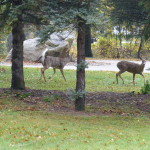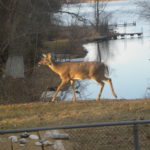People in Eastern Iowa planting young trees to replace those shattered by the August 10 Derecho need to remember an important step. Protect those vulnerable and valuable young trees.
Here is our story. A distressing sight greeted us one September morning a few years ago as we walked to the mailbox to get the newspaper. Overnight a deer had chosen our favorite young maple tree to polish his antlers. He was thorough and had rubbed the bark off all around the two-inch diameter trunk. It was girdled and doomed.
We should have known better. Buck deer start growing their antlers in April and by about Labor Day, they are full size. Antlers are formed by a blood-rich skin called velvet. By late summer it has dried and bucks rub it off polishing up their antlers for dominance battles with rivals. By neglecting to protect our tree we gave a buck a great rubbing place. And doomed our tree to an early death.
Deer begin rubbing in early fall and sometimes continue until the deer mating season approaches in early November. Deer live in most American cities and regularly roam through suburbs. They are as happy to rub their antlers on an ornamental tree in the front yard as on one back in the woods. It’s never good for the tree.
Deer seem to prefer to rub on saplings with trunks a few inches in diameter. They especially seem to prefer pine and black cherry trees but we have even lost young spruces to their rubs. One thing is predictable. The tree that a family most treasures is the one a buck is likely to destroy.
Damage is preventable. We now run a four-foot-high circle of wire mesh around the tree and wire it to a fence post hammered securely into the ground. Once a tree reaches five or six inches in diameter deer rarely bother them, so the wire is only needed for a few years.
Be sure to water your new, young fall-planted tree. And, protect it with wire mesh.
- With polished antlers, this muledeer buck proudly strode across the meadow. Whitetails are more common in the East and Midwest. “Mulies” are common in the High Plains and west.
- On Halloween day a buck was hot on the “tail” of this doe and yearling.
- Deer in yard.





A number of years ago when my peach trees were very young,
I found the wire fence that I had placed dutifully around them
strewn about the lawn. One was never to be found…maybe on
some buck’s antlers. to say that the peach trees were decimated
is an understatement. I did cut them back and placed the cages
around them again. I also put an additional cage on the outside
of that. The peach trees are much taller now, but if not protected would be vulnerable. The young maple tree near the garage is fairing well even though the new growth was nipped earlier. Well, what can I say? Deer have to do their thing too.